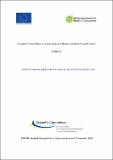Por favor, use este identificador para citar o enlazar a este item:
http://hdl.handle.net/10261/90052COMPARTIR / EXPORTAR:
 SHARE
BASE SHARE
BASE
|
|
| Visualizar otros formatos: MARC | Dublin Core | RDF | ORE | MODS | METS | DIDL | DATACITE | |

| Título: | Addictiveness and sttractiveness of tobacco additives |
Autor: | Thomsen, Mogens; Rodríguez-Farré, Eduard | Palabras clave: | Target groups Waterpipe Smoking Smokeless tobacco SCENIHR Addictiveness Additives Attractiveness Cigarettes Nicotine |
Fecha de publicación: | 2010 | Editor: | European Commission | Citación: | Addictiveness and sttractiveness of tobacco additives (2010) | Resumen: | The Scientific Committee on Emerging and Newly Identified Health Risks (SCENIHR) has been asked to evaluate the role of tobacco additives in the addictiveness and attractiveness of tobacco products. The criteria for dependence established in humans indicate that tobacco has a high addictive potential, but it remains difficult to assess the addictiveness of individualadditives. In animal studies the addictive potency of the final tobacco product cannot be assessed. The reinforcing potency of drugs is measured after intravenous injections and suggests that the abuse liability of pure nicotine is weaker than the addictive potential of tobacco products in humans. The currently used methods to define addictiveness of nicotine and additives are thus not considered adequate. In humans, the positive correlation between tobacco consumption and dependence suggests that individuals with high nicotine levels in their blood are more dependent. In animal studies using self-administration, an inverted U-shaped dose-response curve has generally been revealed suggesting that the addictiveness of nicotine is not directly linearwith the dose. There is however substantial variation in the response to nicotine in both animals and humans, and genetic factors probably play an important role. No tobacco additives which are addictive by themselves have so far been identified. However, sugars, polysaccharides and cellulose fibres which are naturally present in tobacco, or sugars added in high quantities to most tobacco products, give rise to numerous aldehydes, such as acetaldehyde, in tobacco smoke. Acetaldehyde given intravenously is self-administered and enhances the addictiveness of nicotine in experimental animals. Additives that facilitate deeper inhalation (e.g. menthol) or inhibit the metabolism of nicotine may enhance the addictiveness of nicotine indirectly. Substances such as ammonia that increase the pH of the tobacco and the smoke, result in higher amounts of uncharged nicotine. However, it is uncertain if more nicotine isabsorbed with higher smoke pH. For smokeless tobacco it seems that an increased pH enhances nicotine absorption in the mouth. The methods used to quantify the addictive potency of additives have limitations because of technical challenges in experimentally manipulating the presence or absence of anadditive in a tobacco product. Such experiments require large technical and financial resources. In addition, there are ethical issues if testing in humans is considered. Due to these limitations, the available methodologies are not considered adequate. A number of technical characteristics of cigarettes (paper, filter, packing, geometry) influence the content of different substances in the smoke and the size of smoke particles. Many smokers compensate for a lower dose of nicotine by increasing puff volume and frequency, and by deeper inhalation. The particle size of the smoke aerosol does not seem to substantially influence the exposure to nicotine. The technical characteristics of cigarettes may thus modulate smoking behaviour but it is uncertain if this leads to a higher risk of addiction. Attractiveness is defined as the stimulation to use a product. The attractiveness of tobacco products may be increased by a number of additives but is also influenced by external factors such as marketing, price etc. Animal models do not currently exist for the assessment of attractiveness. In humans, the attractiveness of individual tobaccoproducts may be compared in panel studies, surveys, and by experimental measures. Another method is to experimentally adjust tobacco products to exclude or include individual additives and test responses to them. However, this type of research is difficult due to ethical considerations that will usually preclude human testing of tobacco products, particularly among non-users or children. The use of fruit and candy flavours seems to favour smoking initiation in young people. Menthol also attracts a number of smokers, in particular African Americans. Some additives decrease the harshness and increase the smoothness of the smoke. Certain additives yield a full and white smoke and other additives reduce the lingering odour of the smoke in order to favour the acceptability of smoking to people around. Additives considered attractive may in principle lead to brand preference or a higher consumption of tobacco products. However, it remains difficult to distinguish the direct effects of these additives from indirect effects such as the marketing towards specific groups. |
Descripción: | SCENIHR (Scientific Committee on Emerging and Newly Identified Health Risks): et al. | Versión del editor: | http://dx.doi.org/10.2772/39398 | URI: | http://hdl.handle.net/10261/90052 | DOI: | 10.2772/39398 | Identificadores: | doi: 10.2772/39398 isbn: 978-92-79-12788-5 |
| Aparece en las colecciones: | (IIBB) Libros y partes de libros |
Ficheros en este ítem:
| Fichero | Descripción | Tamaño | Formato | |
|---|---|---|---|---|
| Addictiveness and sttractiveness.pdf | 891,69 kB | Adobe PDF |  Visualizar/Abrir |
CORE Recommender
Page view(s)
378
checked on 24-abr-2024
Download(s)
270
checked on 24-abr-2024
Google ScholarTM
Check
Altmetric
Altmetric
NOTA: Los ítems de Digital.CSIC están protegidos por copyright, con todos los derechos reservados, a menos que se indique lo contrario.
